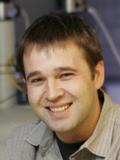Physical chemists endeavor to explain chemical systems with all of their diversity and complexity using powerful and elegant models that often rest on molecular-level understanding. State-of-the-art experimental and computational facilities support cutting-edge research by more than fifteen groups at Ohio State. Researchers in the physical division study phenomena that take place in chemical environments ranging from the gas phase, conventional and ionic liquids, solid surfaces, and interfaces. The phenomena of interest span a vast range of time and energy scales from ultrafast processes in materials and DNA to long-time dynamics of biomolecules. Faculty members in the physical division are acknowledged leaders in their fields. The students and postdocs who train with them find positions in academia, national and government laboratories, and companies ranging from small startups to large, multinational corporations.
Research Areas
- Atmospheric chemistry
- Bioinorganic chemistry
- Catalysis
- Chemical information and modeling
- Computational chemistry
- Environmental chemistry
- Materials
- Laser spectroscopy
- Molecular biophysics and structural biology
- Nanoscience and nanotechnology
- NMR spectroscopy
- Photophysics and photochemistry
- Protein structure and folding
- Solar energy conversion
- Theoretical chemistry
- Ultrafast spectroscopy
- Quantum chemistry
Resources
Between the department's NMR lab and the Campus Chemical Instrument Center, Ohio State has some of the best NMR facilities in the world, including specialized instrumentation for solution and solid-state NMR and microimaging. Several research groups in physical division are working on the development of new NMR techniques for elucidating the structure and dynamics of materials, batteries, and biomolecules. There is also outstanding instrumentation for ultrafast spectroscopy with light sources that span the mid-IR to the soft x-ray.
Many groups in the division use computer modeling and simulation to inform and guide their research. Additionally, four theoretical groups conduct research encompassing quantum chemistry, statistical mechanics, biomolecular dynamics, and computer-aided drug discovery. Computer simulations are performed using state-of-the-art computational resources. Facilities at the nearby Ohio Supercomputer Center offer some of the best high-performance computing resources available to academic researchers anywhere.
Faculty

Atmospheric aerosols, pulmonary surfactant, and interfacial electric fields are investigated by surface spectroscopy and imaging methods to reveal the driving forces of molecular organization that then impact atmospheric chemistry and lung function. Advanced surface spectroscopic methods are also being developed.
- Experimental Physical Chemistry & Spectroscopy
- Lipids & Membranes
- Environmental Science

Ultrafast X-ray spectroscopy, Catalysis for energy conversion and storage, CO2 reduction, Water oxidation, Interfacial charge transfer, Nanoparticle catalysis
- Experimental Physical Chemistry & Spectroscopy
- Catalysis
- Surfaces & Interfaces

Our research program focuses on protein dynamics (enzymes, regulatory and intrinsically disordered proteins) in relationship to function using NMR and long MD simulations. It also covers Metabolomics of complex biological samples to uncover the metabolic response to health and disease.
- Molecular Biophysics & Structural Biology
- NMR
- Theory & Computation

Our research interests focus on the use of magnetic resonance to probe dynamics and structure in non-crystalline solids and energy-related materials. Motivated by the challenges of such difficult-to-characterize materials we have developed numerous magnetic resonance methodologies, theories, and analyses over the years.
- Experimental Physical Chemistry & Spectroscopy
- NMR
- Inorganic Materials

Electronic structure theory and molecular quantum mechanics, especially for condensed-phase systems and excited states; development of quantum chemistry software.
- Theory & Computation
- Chemical Information & Modeling
- Photochemistry

Development of multidimensional solid-state NMR methods and their applications to structural and dynamic analysis of large biomacromolehummocular protein-protein and protein-DNA assemblies, including amyloids and chromatin.
- Experimental Physical Chemistry & Spectroscopy
- Molecular Biophysics & Structural Biology
- NMR

Femtosecond spectroscopy of biomolecules and nanomaterials for solar energy conversion and photocatalysis; photoinduced proton-coupled electron transfer in molecular and nanoscale systems; exciton and carrier dynamics in earth-abundant metal oxides.
- Experimental Physical Chemistry & Spectroscopy
- Solar Energy Conversion
- DNA & Chromatin

Our group develops theory for condensed phases: liquids, solids, and aerosol droplets. Recent interest, which relates to nanotechnology, explores how electric fields can direct fluid flow in small channels. We have also developed a successful theory for transitions among the many phases of ice. Our interests also extend to the properties of amyloid fibrils.
- Theory & Computation
- Nanoscience & Nanotechnology
- Surfaces & Interfaces

Research in the Sokolov group aims to develop new theoretical methods for the simulations of light-induced and non-equilibrium processes in chemical systems with complex electronic structure.
- Theory & Computation
- Physical Inorganic Chemistry
- Photochemistry

The Carpenter group will focus on fundamental relationships between the chemical and physical properties of nanoparticles made from biological building blocks. As these nanoparticles are made of molecules like proteins or lipids, they are self-assembled by many weak noncovalent interactions, but they ultimately form singular objects.

The Dodin Group will be developing new theories and computational methods for a wide range of applications in electrochemistry, atmospheric chemistry, biophysics, and quantum technology

The Manna lab integrates high-throughput microfluidic-based selection methods with single-molecule techniques to study and engineer photo-switching proteins, light-harvesting complexes, and plastic-degrading enzymes.
